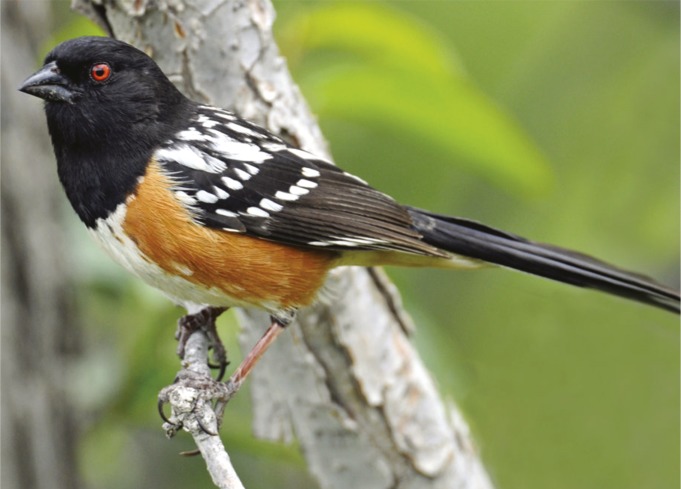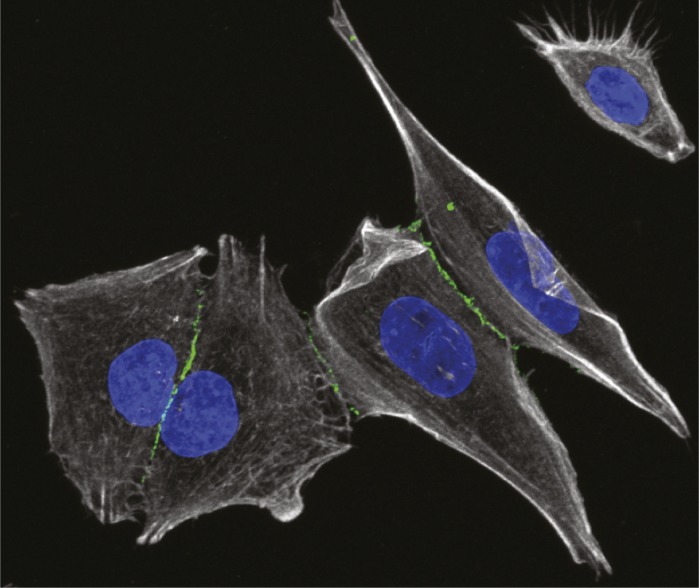Quantum entanglement over large distances
Green beacon laser is sent from the Optical Ground Station on Tenerife to La Palma. Image courtesy of the Institute for Quantum Optics and Quantum Information, Vienna.
In quantum mechanics, two particles can be in an entangled state, such that any change in the state of one of the particles affects the state of the other, regardless of the distance between them. Two entangled pairs can be made to exchange partners in a process known as entanglement swapping. Thomas Herbst et al. (pp. 14202–14205) detected entanglement swapping over a distance of 143 km, between the Canary Islands La Palma and Tenerife. Four photons were created at La Palma. Photon “0” was entangled with photon “1” and photon “2” was entangled with photon “3.” The authors then swapped the entanglement of the individual pairs to photons “0” and “3,” which had not previously interacted. The authors observed correlations between the polarization of photon “3,” measured at Tenerife, and the polarization of photon “0,” measured at La Palma, demonstrating entanglement between photons “0” and “3.” The authors propose that long-distance entanglement swapping could be used for secure communication and distributed quantum computing in a future global quantum internet. In a related article, Mario Krenn et al. (pp. 14197–14201) observed entanglement between the polarization of one photon and the orbital angular momentum (OAM) of a second photon. Because the range of possible OAM states is much broader than the range of polarization states, OAM can encode more information per photon, compared with polarization. However, OAM is affected by atmospheric turbulence, potentially limiting the range over which OAM entanglement can be detected. The authors measured the entangled photons at two points in Vienna that were 3 km apart, and found a significant correlation between the polarization of one photon and the OAM of the other. The authors demonstrated that up to 11 OAM channels can be detected using the equipment. According to the authors, further technological improvements could increase the number of detectable OAM channels. — B.D.
North American birds and West Nile virus
A spotted towhee, whose survival estimates seem to have rebounded after being affected by West Nile virus. Image courtesy of Paul Higgins (photographer).
West Nile virus has been associated with the deaths of millions of native birds since its introduction to North America in 1999. However, the impact of the virus across species has not been well documented. T. Luke George et al. (pp. 14290–14294) examined the effects of West Nile virus on 49 bird species using mark-recapture data from over 500 bird-banding stations across the United States spanning the period 1992–2007. The authors found significant declines in survival rates associated with West Nile virus for 23 out of 49 species studied. For 11 of these 23 species, survival rates declined during the initial arrival of the virus, but later recovered to previrus estimates. For the remaining 12 species, survival rates declined and remained below previrus estimates in subsequent years. The New World sparrow, finch, and vireo groups each contained a disproportionally large number of species affected by the virus, suggesting that phylogeny may affect species susceptibility to the virus. The results suggest that introduction of infectious diseases may have large, long-term impacts on native populations, according to the authors. — B.D.
Impact of Ebola control measures in Sierra Leone
The introduction of Ebola control measures in Sierra Leone led to a decline in Ebola virus disease (EVD) cases from late 2014 to early 2015 in many districts, but the relative contributions of different control measures to this decline are unclear. A concerted local and international response led to the introduction of thousands of Ebola treatment beds alongside other infection control measures. Adam Kucharski et al. (pp. 14366–14371) developed a mathematical model of EVD transmission to estimate how many EVD cases were averted due to the introduction of additional treatment beds in the 12 districts of Sierra Leone. The authors found that the effect varied considerably by district, with large impacts in districts with large outbreaks. The authors estimated that 56,600 EVD cases, including reported and unreported infections, were averted in Sierra Leone between June 2014 and February 2015 as a direct result of additional treatment beds, which likely prevented around 40,000 Ebola deaths in the country. In addition, the authors found that if these beds had been introduced 1 month earlier, a further 12,500 cases could have been averted. The results highlight the highly variable nature of Ebola transmission, and the authors suggest that the local and international response to the Ebola outbreak in Sierra Leone led to a substantial decline in EVD transmission during 2014–2015. — S.R.
Restoring biodiversity after severe environmental stress
Severe environmental stress can sharply curtail biodiversity in an ecological community by killing off entire species and altering ecosystem dynamics. Although such losses can be recovered, little is known about the conditions that allow biodiversity to reestablish itself. Etienne Low-Décarie et al. (pp. 14307–14312) investigated this community-scale phenomenon through the lens of evolutionary rescue, a theory which holds that evolution can respond rapidly enough to avert extinction in individual species with sufficiently large and interconnected populations. Focusing on communities of soil microbes exposed to a herbicide, the authors studied how populations within complex communities evolve after an environmental disturbance eliminates all the constituent organisms. Soil microbes, the authors report, can adapt and extend to repopulate areas that were rendered uninhabitable by a previous environmental challenge, thus providing a mechanism whereby a functional community can persist despite declining environmental conditions. Furthermore, the authors found that these reequilibrations, dubbed community rescue, are more likely to occur in assemblages that are initially large and diverse and where local populations are connected by dispersal, or when a community has previously survived a less severe stress. The findings point to a theory of rescue that can be applied at the population and community scales, according to the authors. — T.J.
Junctional proteins and Staphylococcus aureus infection
Adherens junction protein PLEKHA7 (green) in human lung epithelial cells.
Staphylococcus aureus is a major human pathogen that secretes a protein called α-toxin, which is essential to its virulence. Lauren Popov et al. (pp. 14337–14342) conducted a genetic screen using human cells to identify host factors that control susceptibility to α-toxin. The authors identified 46 genes that control α-toxin toxicity, including several components of adherens junctions—protein complexes that occur at junctions between cells. The authors found that the second most significantly enriched gene in the screen was a cytoplasmic member of adherens junctions called plekstrin-homology domain containing protein 7 (PLEKHA7). Cells lacking PLEKHA7 showed decreased susceptibility to α-toxin toxicity and enhanced ability to recover from α-toxin injury. In addition, when mice lacking PLEKHA7 were infected with a strain of methicillin-resistant S. aureus (MRSA), they exhibited decreased disease severity and improved postinfection healing during both self-resolving skin infection and lethal MRSA pneumonia. The results suggest that adherens junction components modulate cellular responses to α-toxin and control the ability of cells to recover from α-toxin injury. The authors suggest that targeting nonessential epithelial junction components such as PLEKHA7 might potentially help reduce S. aureus virulence. — S.R.





